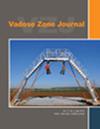Quantitative analysis of diurnal CO2 flux variations above an alkaline playa
IF 2.8
3区 地球科学
Q3 ENVIRONMENTAL SCIENCES
引用次数: 0
Abstract
Abstract The alkaline playas at Atlin, BC, provide a unique opportunity for studying the carbonate–bicarbonate system and carbonate mineral stability at the Earth's surface. In this study, dynamic closed chambers (DCCs) and pore‐gas sampling were used to directly quantify carbon dioxide (CO 2 ) emission rates and characterize processes governing the CO 2 exchange across the playa‐atmosphere interface. Data were collected at the Atlin site continuously over 27 days in 2020 and 14 days in 2021. Results indicate minimal net exchange of CO 2 across the playa‐atmosphere interface during the monitoring periods, with average fluxes over the two periods of −0.03 and 0.09 µmol m −2 s −1 in 2020 and 2021, respectively. However, distinct diurnal oscillations of CO 2 fluxes were measured with average daytime fluxes of 0.15 ± 0.34 µmol m −2 s −1 (2020) and 0.15 ± 0.19 µmol m −2 s −1 (2021) and nighttime fluxes of −0.24 ± 0.31 µmol m −2 s −1 (2020) and 0.04 ± 0.18 µmol m −2 s −1 (2021). These observations, supported by reactive transport modeling, indicate that CO 2 exchange is predominantly governed by changes in CO 2 solubility in alkaline porewater related to diurnal temperature fluctuations and variations in CO 2 concentrations in ambient air above the ground surface. Even though CO 2 concentrations exceed 8000 ppmv at 1‐m depth, CO 2 emissions to the atmosphere were found to be minimal, likely due to high moisture contents, low connectivity, and tortuosity, limiting upward CO 2 migration. These findings provide insights into CO 2 flux dynamics in alkaline arid regions and show promise for the application of the DCC method for monitoring ex situ carbon mineralization at sites with enhanced mineral weathering.碱性盐湖上CO2日通量变化的定量分析
不列颠哥伦比亚省Atlin的碱性playas为研究地球表面碳酸盐-重碳酸盐体系和碳酸盐矿物稳定性提供了独特的机会。在这项研究中,使用动态封闭室(DCCs)和孔隙气体取样来直接量化二氧化碳(co2)排放率,并表征控制co2在playa -大气界面交换的过程。在Atlin站点连续收集数据,2020年超过27天,2021年超过14天。结果表明,在监测期间,通过playa -大气界面的CO 2净交换最小,在2020年和2021年两个周期的平均通量分别为- 0.03和0.09µmol m - 2 s - 1。然而,co2通量的日波动明显,平均白天通量为0.15±0.34µmol m−2 s−1(2020)和0.15±0.19µmol m−2 s−1(2021),夜间通量为- 0.24±0.31µmol m−2 s−1(2020)和0.04±0.18µmol m−2 s−1(2021)。这些观测结果得到反应输移模型的支持,表明co2交换主要受碱性孔隙水中co2溶解度的变化所控制,这些变化与昼夜温度波动和地表以上环境空气中co2浓度的变化有关。尽管co2浓度在1 m深度超过8000ppmv,但co2向大气的排放却很少,这可能是由于高水分含量、低连通性和弯曲性,限制了co2向上迁移。这些发现提供了对碱性干旱区CO 2通量动力学的见解,并为DCC方法在矿物风化增强地点监测非原位碳矿化提供了希望。
本文章由计算机程序翻译,如有差异,请以英文原文为准。
求助全文
约1分钟内获得全文
求助全文
来源期刊

Vadose Zone Journal
环境科学-环境科学
CiteScore
5.60
自引率
7.10%
发文量
61
审稿时长
3.8 months
期刊介绍:
Vadose Zone Journal is a unique publication outlet for interdisciplinary research and assessment of the vadose zone, the portion of the Critical Zone that comprises the Earth’s critical living surface down to groundwater. It is a peer-reviewed, international journal publishing reviews, original research, and special sections across a wide range of disciplines. Vadose Zone Journal reports fundamental and applied research from disciplinary and multidisciplinary investigations, including assessment and policy analyses, of the mostly unsaturated zone between the soil surface and the groundwater table. The goal is to disseminate information to facilitate science-based decision-making and sustainable management of the vadose zone. Examples of topic areas suitable for VZJ are variably saturated fluid flow, heat and solute transport in granular and fractured media, flow processes in the capillary fringe at or near the water table, water table management, regional and global climate change impacts on the vadose zone, carbon sequestration, design and performance of waste disposal facilities, long-term stewardship of contaminated sites in the vadose zone, biogeochemical transformation processes, microbial processes in shallow and deep formations, bioremediation, and the fate and transport of radionuclides, inorganic and organic chemicals, colloids, viruses, and microorganisms. Articles in VZJ also address yet-to-be-resolved issues, such as how to quantify heterogeneity of subsurface processes and properties, and how to couple physical, chemical, and biological processes across a range of spatial scales from the molecular to the global.
 求助内容:
求助内容: 应助结果提醒方式:
应助结果提醒方式:


